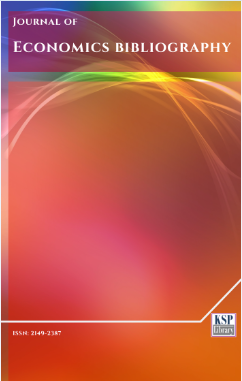Puzzling Features of the Historical Income per Capita Distributions Explained
Abstract
Abstract. Distributions describing the growth ofthe Gross Domestic Product per capita (GDP/cap) arepuzzling. They show that income per capita was approximately constant over hundreds of years, maybe even over thousands of years, but then, as if suddenly it started to increase.The growth was changed apparently rapidly from approximately horizontal to approximately vertical.Numerous efforts have been made to explain these features but we show that they represent nothing more than the purely mathematical property of dividing two hyperbolic distributions. Historical growth of income per capita can be explained as having been controlled by the simple and familiar forces of growth.
Keywords. Income per capita, Gross Domestic Product, Growth of population, Hyperbolic growth.
JEL. A10, A12, A20, B41, C02, C12, C20, C50, Y80.
Keywords
References
Ashraf, Q.H. (2009). Essays on Deep Determinants of Comparative Economic Development. Ph.D. Thesis, Department of Economics, Brown University, Providence.
Floud, D. & McCloskey, D.N. (1994). The Economic History of Britain since 1700. Cambridge: Cambridge University Press.
Galor, O. (2005a). From stagnation to growth: Unified Growth Theory. In P. Aghion & S. Durlauf (Eds.), Handbook of Economic Growth (pp. 171-293). Amsterdam: Elsevier.
Galor, O. (2005b). The Demographic Transition and the Emergence of Sustained Economic Growth. Journal of the European Economic Association, 3, 494-504. doi. 10.1162/jeea.2005.3.2-3.494
Galor, O. (2007). Multiple Growth Regimes-Insights from Unified Growth Theory. Journal of Macroeconomics, 29(3), 470-475. doi. 10.1016/j.jmacro.2007.06.007
Galor, O. (2008a). Comparative Economic Development: Insight from Unified Growth Theory. [Retrieved from].
Galor, O. (2008b). Economic Growth in the Very Long Run. In: Durlauf, S.N. & Blume, L.E., Eds., The New Palgrave Dictionary of Economics, Palgrave Macmillan, New York. doi. 10.1057/9780230226203.0434
Galor, O. (2008c). Comparative Economic Development: Insight from Unified Growth Theory. [Retrieved from].
Galor, O. (2010). The 2008 Lawrence R. Klein Lecture—Comparative Economic Development: Insights from Unified Growth Theory. International Economic Review, 51(1), 1-44. doi. 10.1111/j.1468-2354.2009.00569.x
Galor, O. (2011). Unified Growth Theory. Princeton, New Jersey: Princeton University Press.
Galor, O. (2012a). Unified Growth Theory and Comparative Economic Development. [Retrieved from].
Galor, O. (2012b). The Demographic Transition: Causes and Consequences. Cliometrica, 6(1), 1-28. doi. 10.1007/s11698-011-0062-7
Galor, O. (2012c). Unified Growth Theory and Comparative Economic Development. [Retrieved from].
Galor, O. & Moav, O. (2002). Natural Selection and the Origin of Economic Growth. The Quarterly Journal of Economics, 117(4), 1133-1191. doi. 10.1162/003355302320935007
Maddison, A. (2001). The World Economy: A Millennial Perspective. Paris: OECD.
Maddison, A. (2010). Historical Statistics of the World Economy: 1-2008 AD. [Retrieved from].
Malthus, T. R. (1798). An Essay on the Principle of Population. London: J. Johnson.
Nielsen, R.W. (2014). Changing the paradigm. Applied Mathematics, 5, 1950-1963. doi. 10.4236/am.2014.513188
Nielsen, R.W. (2016a). Mathematical analysis of the historical economic growth with a search for takeoffs from stagnation to growth. Journal of Economic Library, 3(1), 1-23.
Nielsen, R.W. (2016b). Unified Growth Theory contradicted by the absence of takeoffs in the Gross Domestic Product. Economic Review, 3(1), 16-27.
Nielsen, R. W. (2016c).The postulate of the three regimes of economic growth contradicted by data. Journal of Economic and Social Thought, 3(1), 1-34.
Nielsen, R.W. (2016d).Unified Growth Theory contradicted by the mathematical analysis of the historical growth of human population. Journal of Economics and Political Economy, 3(2), 242-263.
Nielsen, R.W. (2016e). Puzzling properties of the historical growth rate of income per capita explained. Journal of Economics Library, 3(2), 241-256.
Nielsen, R.W. (2016f). The unresolved mystery of the great divergence is solved. Journal of Economic and Social Thought, 3(2), 196-219.
Nielsen, R.W. (2016g). Mathematical analysis of the historical income per capita distributions. Economic Review, 3(2), 300-319.
Nielsen, R.W. (2016h). Industrial Revolution did not boost the economic growth or the growth of population even in the United Kingdom. Journal of Economic Bibliography, 3(4), 434-446.
Nielsen, R.W. (2016i). Growth of the world population in the past 12,000 years and its link to the economic growth. Journal of Economics Bibliography, 3(1), 1-12.
Nielsen, R. W. (2016j). Mechanism of Hyperbolic Growth Explained. Journal of Economic Library, 3(4), 411-428.
Snowdon, B. & Galor, O. (2008). Towards a Unified Theory of Economic Growth. World Economics, 9, 97-151.
von Foerster, H., Mora, P., & Amiot, L. (1960). Doomsday: Friday, 13 November, A.D. 2026. Science, 132, 1291-1295.
DOI: http://dx.doi.org/10.1453/jeb.v4i1.1155
Refbacks
- There are currently no refbacks.
.......................................................................................................................................................................................................................................................................................................................................
Journal of Economics Bibliography - J. Econ. Bib. - JEB - www.kspjournals.org
ISSN: 2149-2387.
Editor: [email protected] Secretarial: [email protected] Istanbul - Turkey.
Copyright © KSP Library

